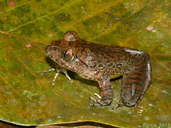|
Astylosternus perreti Amiet, 1978
| family: Arthroleptidae genus: Astylosternus |
| Species Description: Amiet , J.-L. (1977). "Les Astylosternus du Cameroun (Amphibia, Anura, Astylosternidae)." Annales de la Faculté des Sciences de Yaoundé, 23–24, 99–227. | |
 © 2013 Daniel Portik (1 of 4) |
|
|
|
Description The tadpoles have a total length from 78.0 - 108.1 mm and a body length of 25.0 mm with a body length to total length ratio of 31.2 ± 2.2%. The ventral-fin-height to dorsal-fin-height ratio is 79.9 ± 6.8%. The keratodont formula is 1:2+2/2+2:1. The anterior lip has only a few lateral papillae. The posterior papillae are organized in two or three rows of 20 - 30 small, broadly triangular (shark tooth shaped) papillae; the medial papillae are larger than the lateral ones. The rostral gaps are large and the jaw sheaths are massive and serrated. The upper jaw is broadly arched with a small medial projection (fang), and the lower jaw narrowly U- to V-shaped (Griesbaum et al. 2019). Dorsal coloration of adults is pale brown, yellow, or sometimes pale red with slightly visible spots or pale marbling. The canthus rostralis is black. The ventral coloration is pale yellow whereas the underside of the throat is pink with brown spots. Brown spots also mark the flanks, separating the dorsal and ventral coloration. The hind limbs have four to seven oblique transversal bars that are uninterrupted, unlike in other Astylosternus (Amiet 1977). Tadpole dorsal coloration is dark brown while the tail is very pale brown to beige. The lateral sacs and ventrum are paler brown or dark gray. A broad, dark brown longitudinal band on the tail axis reaches to about the middle or two-thirds of the tail length, the proximate end of the tail has smaller dark speckles, and the fins are pale yellowish beige. The jaw sheaths are black (Griesbaum et al. 2019). Distribution and Habitat Country distribution from AmphibiaWeb's database: Cameroon
Life History, Abundance, Activity, and Special Behaviors On Mt. Nlonako and Mt. Kupe A. perreti was found to occur at the same sites as A. diadematus and A. montanus (Hofer 1999; Plath et al. 2004). Trends and Threats Relation to Humans Comments
References
Amiet, J.-L. (1977). ''Les Astylosternus du Cameroun (Amphibia Anura, Astylosterninae).'' Annales de la Faculté des Sciences de Yaoundé, 23/24, 99-227. Blackburn, D. C., Hanken, J., Jenkins Jr, F. A. (2008). "Concealed weapons: erectile claws in African frogs." Biology Letters 4, 355–357. [link] Griesbaum, F., Hirschfeld, M., Barej, M. F., Schmitz, A., Rohrmoser, M., Dahmen, M., Mühlberer, F., Liedtke, H.C. Gonwouo, N.L., Doumbia, J., Rödel, M. O. (2019). "Tadpoles of three western African frog genera: Astylosternus Werner, 1898, Nyctibates Boulenger, 1904, and Scotobleps Boulenger, 1900 (Amphibia, Anura, Arthroleptidae)." Zoosystematics and Evolution, 95, 133–160. [link] Herrmann, H.-W., Böhme, W., Herrmann, P.A., Plath, M., Schmitz, A., Solbach, M. (2005). ''African biodiversity hotspots: the amphibians of Mt. Nlonako, Cameroon.'' Salamandra, 41(1/2), 61–81. Hofer U, Bersier L-F, Borcard D (1999). ''Spatial organization of a herpetofauna on an elevational gradient revealed by null model tests.'' Ecology, 80(3), 976–988. [link] IUCN SSC Amphibian Specialist Group. (2018). "Astylosternus perreti." The IUCN Red List of Threatened Species 2018: e.T54422A95847819. https://dx.doi.org/10.2305/IUCN.UK.2018-1.RLTS.T54422A95847819.en. Accessed on 19 January 2022. Portik DM, Bell RC, Blackburn DC, Bauer AM, Barratt CD, Branch WR, Burger M, Channing A, Colston TJ, Conradie W, Dehlin JM, Drewes RC, Ernst R, Greenbaum E, Gvozdík V, Harvey J, Hillers A, Hirschfeld M, Jongsma GFM, Kielgast J, Kouete MT, Lawson LP, Leaché AD, Loader SP, Lötters S, van der Meijden A, Menegon M, Müller S, Nagy ZT, Ofori-Boateng C, Ohler A, Papenfuss TJ, Rößler D, SinschU, Rödel MO, Veith M, Vindum J, Zassi-Boulou AG, McGuire JA (2019). ''Sexual dichromatism drives diversification within a major radiation of African amphibians.'' Systematic Biology , 68(6), 859-875. [link] Originally submitted by: Kaitlin E. Allen, Magali Zoungrana, David C. Blackburn (2022-04-27) Description by: Kaitlin E. Allen, Magali Zoungrana, David C. Blackburn (updated 2022-04-27)
Distribution by: Kaitlin E. Allen, Magali Zoungrana, David C. Blackburn (updated 2022-04-27)
Life history by: Kaitlin E. Allen, Magali Zoungrana, David C. Blackburn (updated 2022-04-27)
Trends and threats by: Kaitlin E. Allen, Magali Zoungrana, David C. Blackburn (updated 2022-04-27)
Relation to humans by: Kaitlin E. Allen, Magali Zoungrana, David C. Blackburn (updated 2022-04-27)
Comments by: Kaitlin E. Allen, Magali Zoungrana, David C. Blackburn (updated 2022-04-27)
Edited by: Ann T. Chang (2022-04-27) Species Account Citation: AmphibiaWeb 2022 Astylosternus perreti <https://amphibiaweb.org/species/1487> University of California, Berkeley, CA, USA. Accessed May 15, 2025.
Feedback or comments about this page.
Citation: AmphibiaWeb. 2025. <https://amphibiaweb.org> University of California, Berkeley, CA, USA. Accessed 15 May 2025. AmphibiaWeb's policy on data use. |



 Map of Life
Map of Life